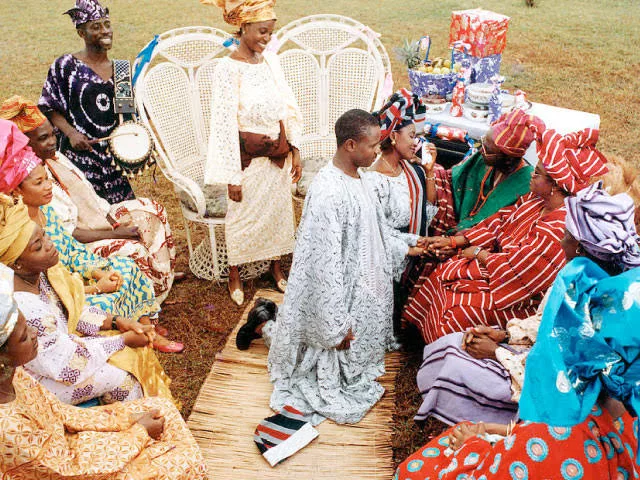Traditional Marriage Rites in Yoruba Land: How It Is Done
HOW TRADITIONAL MARRIAGE RITES IN YORUBA LAND IS DONE
The Yoruba ethnic group is one of the major ethnic groups in Nigeria. They dominate all the states in south west Nigeria (Oyo State, Osun, Ogun, Ondo, Ekiti and Lagos State) referred to as Yorubaland and a part of Kogi and Kwara.

In the Yoruba culture, before a man can legally call a woman his wife, there are some marital rites that must be performed. This post will highlight the traditional marriage rites in Yoruba land, its requirements and bridal list.
To the Yoruba ladies that have reach the age of marriage, a husband is seen as a crown and a single woman is seen as a crownless woman. So, if you have gotten your eyes on a Yoruba maiden, roll off your sleeves, unbox your money pack and make her a queen by marrying her.
It all starts formally with informing your people. The steps including the marriage ceremony are highlighted below:
A MAN MAKES A CHOICE AND HIS FAMILY CARRY OUT INVESTIGATION
There’s no room for forced marriage in the Yoruba culture. A man first meets a girl and with her consent, he informs his family on his decision to get married.
This is usually after a kind of dating though it could still be without it. In some cases when the man is not around probably away from his village or his parents, his parents/family does the selection for him with his consent.
After the choice of whom to marry by the man and informing his family, the family takes it up from there. they select an Alarina which is a middleman or a chaperon. The Alarina acts as the middleman and start the marriage process formally.
He starts investigation about the maiden in question and her family. He simply inquires everything and anything that will put the man and his family in a bad situation should their son get married to that lady.
These could be either if the girl or her family have a bad reputation or illness or have a trait they wouldn’t want to have in their family. If he finds a reason for the man not to marry the girl, the marriage process is cut-off from there.
That’s how it is done in the Yoruba marriage tradition. If he doesn’t find anything bad to hold on to, the traditional marriage process continues.
MEETING WITH THE BRIDE’S FAMILY (MOMI N MO)
Having proven by the Alarina that the girl is worth marrying their son, the groom’s family arrange for an informal meeting with the bride’s family for the first time, this meeting is known as Momi N Mo.
This is usually done at the bride to be family house and only close kin are involved. After this meeting, formal courting begins and they fix a date for a formal meeting.
At the formal meeting which is now known as the Introduction Ceremony and no longer a close kin affair does not need an Alarina, the bride’s family provide a list of items known as Eru Iyawo which is the Yoruba bridal list. It is at this meeting that the date of the traditional marriage ceremony is set.
THE YORUBA TRADITIONAL MARRIAGE BRIDAL LIST (ERU IYAWO)
This consist of 42 big tubers of yam, Palm oil and vegetable oil (25 liters), Honey (1 big bottle), 4. Kola nut (25 pieces), Bitter Kola, Alligator pepper (42 pieces), Sugar cane, Fruits (different types), Cow or goat, Salt, Alcoholic drinks, the bride price (called Owo Ori), Dried fish (42 pieces) and1 dish of peppered corn meal (adun).
Also added in today modern world is 4 crates of canned or bottled soft drinks, 4 crates of malt non-alcoholic drink, 2 bottles of non-alcoholic wine, 2 cartons of fruit juice, 1 bag of rice, 1 umbrella, 1 big suitcase that contains shoes and matching bags, different types of fabric ranging from Ankara to lace, including gele and aso oke for the bride, 1 complete jewelry set with wrist watch, earrings and neck chains, engagement ring and a Bible or Quran
THE YORUBA TRADITION ENGAGEMENT CEREMONY
This is the formal traditional marriage ceremony which is usually followed by a church wedding in the case of a Christian couple or what is loosely known as wedding Fatiha in the case of a Muslim couple.
Suffix to say, this is what is known as the traditional wedding and people are invited to come witness. On this day, the ceremony is anchored by two people; the Alaga Ijoko from the bride’s family who is usually a female and the Alaga Iduro who’s from the groom’s family.
The programme of the day starts when the Alaga Idoru usher in the groom and his people to the ground. They are usually barred from entering by the Alaga Ijoko who is then given money before the groom and his people are allow in with singing and dancing.
They go to where the bride’s family sits and greet them. The males prostrate while the females kneel down. After the greeting, the youngest female from the bride’s family read out the letter earlier given to them by the groom’s family asking for the hand of the bride in marriage.
After another series of greeting from the groom and his friends, he is then asked to make his intention known and for him to ask for the bride’s hand in marriage.
During all these, the bride is still not present at the ground. She then along with her group of friends serving as escorts come to the ground. She is veiled and come in, dancing with her friends.
She first proceeds to her parents kneel down while they pray for her after which she proceeds to the groom’s parents for the same thing. The groom’s parents unveil her. She then proceeds to her husband and dress him up with the traditional Yoruba cap known as Fila – this is her own way of showing acceptance!
The Alaga Ijoko will then instruct the bride to go to the place where the bridal items are kept to choose the most valuable item there and she will go there and pick up either the Quran or the Bible which has a ring attached to it. She proceeds to where the groom is and he fix hers’ in her finger while she does same.
At this point, it is obvious that the duo is ready for the union. Dowry is known handed to the bride’s family who then take a little out of it and return it saying all they need is not money, that their daughter should be taken care of.
This signifies the end of the traditional marriage rites in the Yoruba culture but then needless to say, there’s going to be a lot of parting and eating afterward.
Now that you have known the marriage process in Yoruba land, the bridal list and other requirements, it is time to make that Yoruba lady a crowned queen by carrying out all the marital rites as outlined by the Yoruba tradition.
